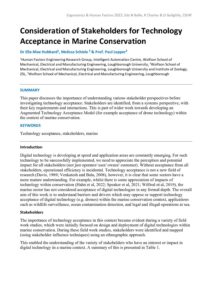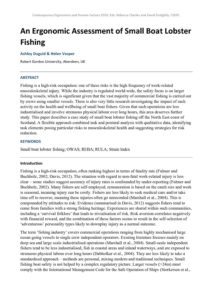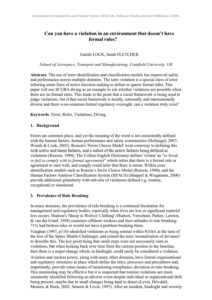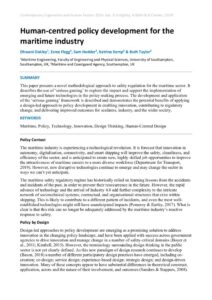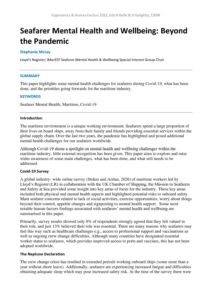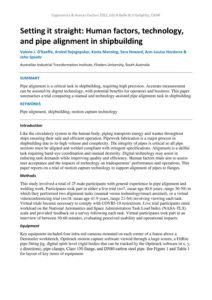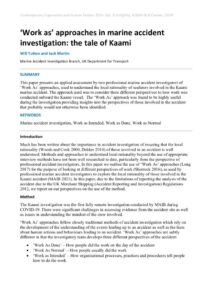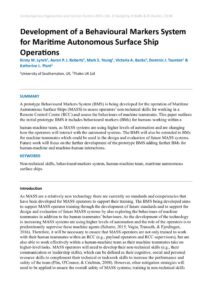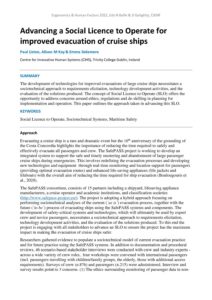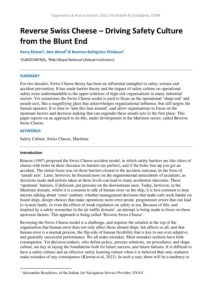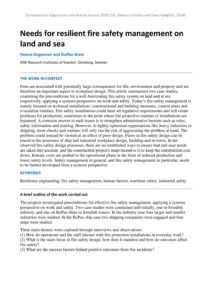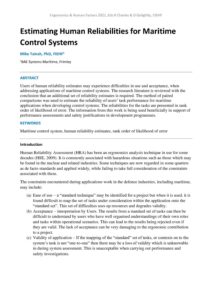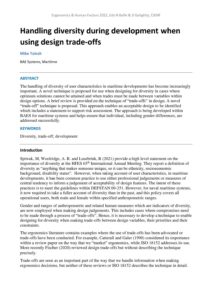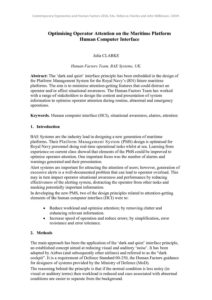Maritime
Consideration of Stakeholders for Technology Acceptance in Marine Conservation
| Document | Author Dr Ella-Mae Hubbard, Melissa Schiele & Prof. Paul Lepper |
| Abstract This paper discusses the importance of understanding various stakeholder perspectives before investigating technology acceptance. Stakeholders are identified, from a systems perspective, with their key requirements and interactions. This is part of wider work towards developing an Augmented Technology Acceptance Model (for example acceptance of drone technology) within the context of marine conservation. |
An Ergonomic Assessment of Small Boat Lobster Fishing
| Document | Author Ashley Duguid & Helen Vosper |
| Abstract Fishing is a high-risk occupation: one of these risks is the high frequency of work-related musculoskeletal injury. While the industry is regulated world-wide, the safety focus is on larger fishing vessels, which is significant given that the vast majority of commercial fishing is carried out by crews using smaller vessels. There is also very little research investigating the impact of such activity on the health and wellbeing of small boat fishers. Given that such operations are less industrialised and involve strenuous physical labour over long hours, this area deserves further study. This paper describes a case study of small boat lobster fishing off the North East coast of Scotland. A flexible approach combined task and postural analysis with qualitative data, identifying task elements posing particular risks to musculoskeletal health and suggesting strategies for risk reduction. |
Can you have a violation in an environment that doesn’t have formal rules?
| Document | Author Gareth LOCK, Sarah FLETCHER |
| Abstract The use of error identification and classification models has improved safety and performance across multiple domains. The term violation is a special class of error inferring some form of active decision making to defeat or ignore formal rules. This paper will use SCUBA diving as an example to ask whether violations are possible when there are no formal rules. This leads to the point that a social framework is being used to judge violations, but if that social framework is locally, nationally and internationally diverse and there is no common formal regulatory oversight, can a violation truly exist? |
Human-centred policy development for the maritime industry
| Document | Author Dhwani Oakley, Esme Flegg, Sam Hodder, Katrina Kemp & Ruth Taylor |
| Abstract This paper presents a novel methodological approach to safety regulation for the maritime sector. It describes the use of ‘serious gaming’ to explore the impact and support the implementation of emerging and future technologies in the policy-making process. The development and application of the ‘serious gaming’ framework is described and demonstrates the potential benefits of applying a design-led approach to policy development in enabling innovation, contributing to regulatory change, and delivering improved outcomes for seafarers, industry, and the wider society. |
Seafarer Mental Health and Wellbeing: Beyond the Pandemic
| Document | Author Stephanie McLay |
| Abstract This paper highlights some mental health challenges for seafarers during Covid-19, what has been done, and the priorities going forwards for the maritime industry. |
Setting it straight: Human factors, technology, and pipe alignment in shipbuilding
| Document | Author Valerie J. O’Keeffe, Arvind Rajagopalan, Kosta Manning, Sara Howard, Ann-Louise Hordacre & John Spoehr |
| Abstract Pipe alignment is a critical task in shipbuilding, requiring high precision. Accurate measurement can be assisted by digital technology, with potential benefits for operators and business. This paper summarises a trial comparing a manual and technology-assisted pipe alignment task in shipbuilding. |
‘Work as’ approaches in marine accident investigation: the tale of Kaami
| Document | Author Will Tutton and Jack Martin |
| Abstract This paper presents an applied assessment by two professional marine accident investigators of ‘Work As’ approaches, used to understand the local rationality of seafarers involved in the Kaami marine accident. The approach used was to consider three different perspectives to how work was conducted onboard the Kaami vessel. The ‘Work As’ approach was found to be highly useful during the investigation providing insights into the perspectives of those involved in the accident that probably would not otherwise been identified. |
Development of a Behavioural Markers System for Maritime Autonomous Surface Ship Operations
| Document | Author Kirsty M. Lynch, Aaron P. J. Roberts, Mark S. Young, Victoria A. Banks, Dominic J. Taunton & Katherine L. Plant |
| Abstract A prototype Behavioural Markers System (BMS) is being developed for the operation of Maritime Autonomous Surface Ships (MASS) to assess operators’ non-technical skills for working in a Remote Control Centre (RCC) and assess the behaviours of machine teammates. This paper outlines the initial prototype BMS it includes behavioural markers (BMs) for humans working within a human-machine team, as MASS systems are using higher levels of automation and are changing how the operators will interact with the automated systems. The BMS will also be extended to BMs for machine teammates which could be used in the design and evaluation of future MASS systems. Future work will focus on the further development of the prototype BMS adding further BMs for human-machine and machine-human interactions. |
Advancing a Social Licence to Operate for improved evacuation of cruise ships
| Document | Author Paul Liston, Alison M Kay & Emma Delemere |
| Abstract The development of technologies for improved evacuations of large cruise ships necessitates a sociotechnical approach to requirements elicitation, technology development activities, and the evaluation of the solutions produced. The concept of Social Licence to Operate (SLO) offers the opportunity to address concerns around ethics, regulations and de-skilling in planning for implementation and operation. This paper outlines the approach taken in advancing this SLO. |
Reverse Swiss Cheese – Driving Safety Culture from the Blunt End
| Document | Author Barry Kirwan, Ben Wood & Beatrice Bettignies-Thiebaux |
| Abstract For two decades, Swiss Cheese theory has been an influential metaphor in safety science and accident prevention. It has made barrier theory and the impact of safety culture on operational safety more understandable to the upper echelons of high-risk organisations in many industrial sectors. Yet sometimes the Swiss Cheese model is used to focus on the operational ‘sharp end’ and unsafe acts, like a magnifying glass that acknowledges organizational influence, but still targets the human operator. It is time to ‘turn this lens around’, and allow organisations to focus on the upstream factors and decision-making that can engender these unsafe acts in the first place. This paper reports on an approach to do this, under development in the Maritime sector, called Reverse Swiss Cheese. |
Needs for resilient fire safety management on land and sea
| Document | Author Helene Degerman and Staffan Bram |
| Abstract Fires are associated with potentially large consequences for life, environment and property and are therefore an important aspect in workplace design. This article summarises two case studies, examining the preconditions for a well-functioning fire safety system on land and at sea respectively, applying a systems perspective on work and safety. Today’s fire safety management is mainly focused on technical installations, constructional and building measures, control plans and evacuation routines. Fire safety installations could meet all regulative requirements and still create problems for production, sometimes to the point where fire protective routines or installations are bypassed. A common answer to such issues is to strengthen administrative barriers such as rules, safety information and training. However, in tightly optimised organisations like heavy industries or shipping, more checks and routines will only run the risk of aggravating the problem at hand. The problem could instead be viewed as an effect of poor design. Flaws in fire safety design can be traced to the processes of ship and industrial workplace design, building and revision. In the observed fire safety design processes, there are no established ways to ensure that end-user needs are taken into account, and the construction project's main incentive is to keep the construction cost down. Instead, costs are pushed to the operational phase in the form of reduced production and lower safety levels. Safety management in general, and fire safety management in particular, needs to be further developed from a systems perspective. |
Estimating Human Reliabilities for Maritime Control Systems
| Document | Author Mike Tainsh |
| Abstract Users of human reliability estimates may experience difficulties in use and acceptance, when addressing applications of maritime control systems. The research literature is reviewed with the conclusion that an additional set of reliability estimates is required. The method of paired comparisons was used to estimate the reliability of users’ task performance for maritime applications when developing control systems. The reliabilities for the tasks are presented in rank order of likelihood of error. The information from this work is being used beneficially in support of performance assessments and safety justifications in development programmes. |
Handling diversity during development when using design trade-offs
| Document | Author Mike Tainsh |
| Abstract The handling of diversity of user characteristics in maritime developments has become increasingly important. A novel technique is proposed for use when designing for diversity in cases where optimum solutions cannot be attained and when trades must be made between variables within design options. A brief review is provided on the technique of “trade-offs” in design. A novel “trade-off” technique is proposed. This approach enables an acceptable design to be identified which includes a statement to support risk assessment. The approach is being developed within BAES for maritime systems and helps ensure that individual, including gender differences, are addressed successfully. |
Optimising Operator Attention on the Maritime Platform Human Computer Interface
| Document | Author Julia CLARKE |
| Abstract The ‘dark and quiet’ interface principle has been embedded in the design of the Platform Management System for the Royal Navy’s (RN) future maritime platforms. The aim is to minimise attention-getting features that could distract an operator and/or affect situational awareness. The Human Factors Team has worked with a range of stakeholders to design the content and presentation of system information to optimise operator attention during routine, abnormal and emergency operations. |
Collisions at Sea: A Systems Analysis of Causal Factors and Countermeasures
| Document | Author Simon MURRAY, Patrick WATERSON, Thomas JUN |
| Abstract Despite established and proven prescriptive safety legislation, accidents regularly occur across all sectors of shipping. Of particular concern is the number of collisions that continue to occur, even when experienced and trained officers are on board and modern navigation aids are in use. Using a systems approach, this paper will highlight common contributory factors, which can lead to collisions and then propose a set of countermeasures which can be used to reduce these types of shipping accidents. |

